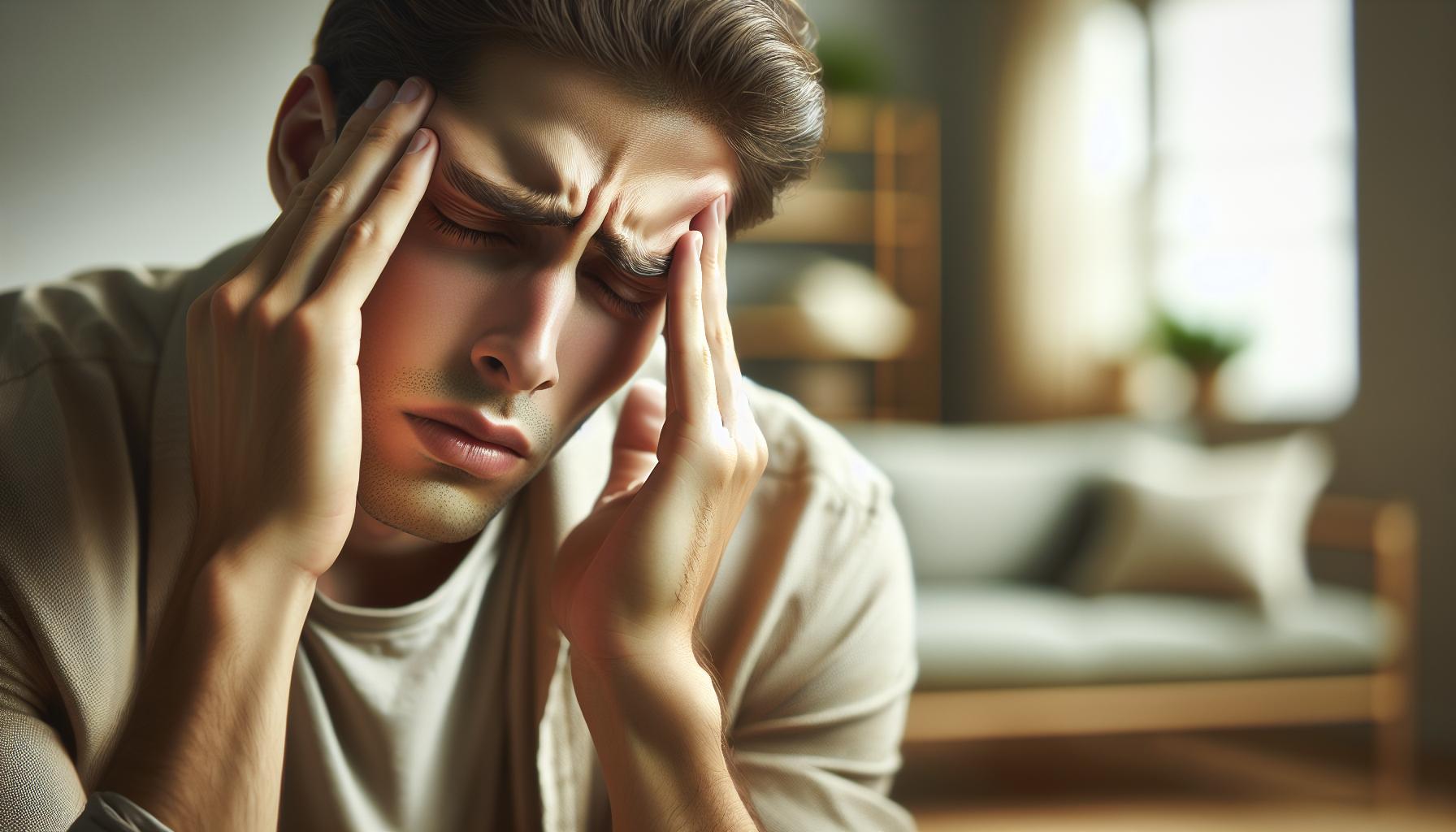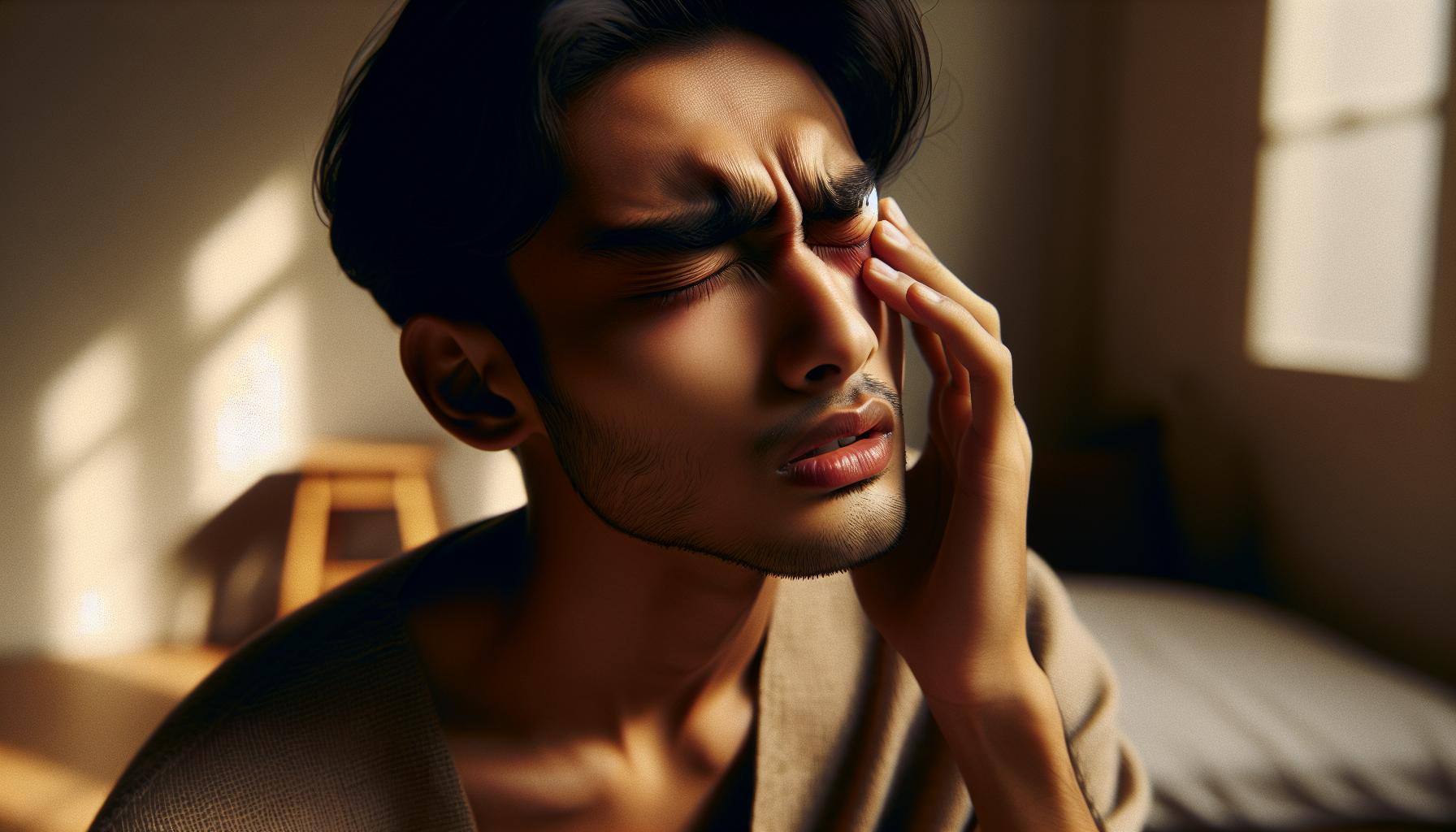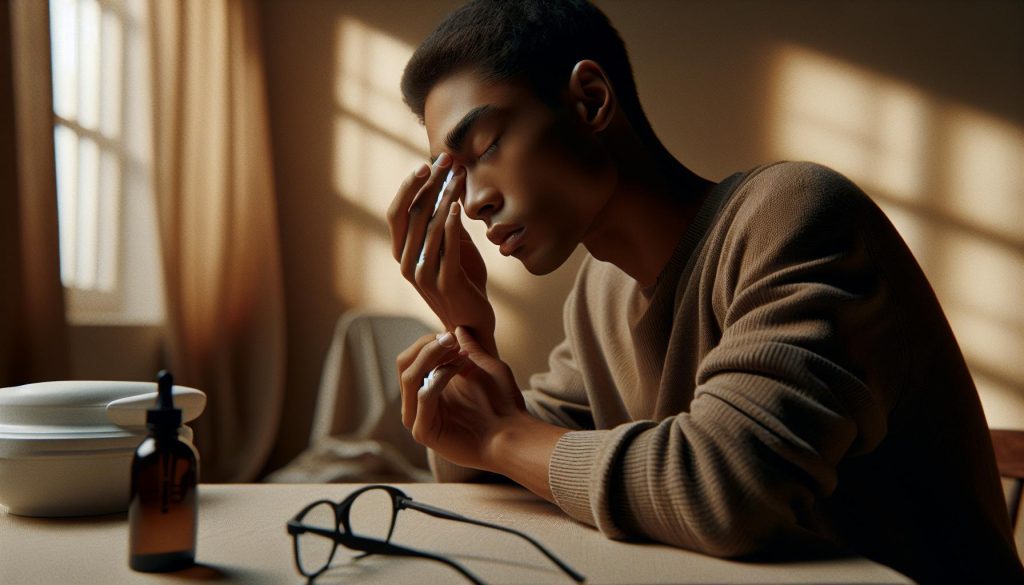Did you know that an eye stye, a common eyelid bump, may not just be a minor annoyance? Surprisingly, it can also lead to headaches. Understanding this hidden pain connection is crucial, especially for those experiencing discomfort that seems to originate from their eyes. A stye occurs when the glands in your eyelid become clogged and can cause swelling, redness, and irritation.
If you’ve ever found yourself battling both an eye stye and a throbbing headache, you’re not alone. Many people overlook the relationship between eye issues and head pain, and this lack of awareness can hinder proper treatment and relief. By exploring the ways a stye can provoke headaches, we empower ourselves with knowledge that promotes better eye health and overall well-being. Join us as we delve into this intriguing connection, offering insights and practical tips to manage and prevent these discomforts effectively.
Can Eye Styes Lead to Headaches? Understanding the Link

There is a significant connection between eye styes and headaches that many people might not immediately recognize. An eye stye, which is a painful, red bump usually caused by a blocked oil gland in the eyelid, can lead to discomfort not only localized around the eye but also manifest as headaches. This relationship often stems from inflammation and irritation within the eye area. When the skin and tissues surrounding the eye become inflamed, the resulting pressure can trigger headaches. Additionally, the body’s response to pain and discomfort can itself be a contributing factor; often, people subconsciously tense the muscles around their eyes and forehead, which may further induce headache symptoms.
When dealing with an eye stye, one may also experience increased sensitivity to light, blurred vision, and swelling, all of which can heighten the likelihood of tension headaches. The eyes are intricately connected to various nerves and pathways that also affect head pain; thus, inflammation in one area can easily lead to painful reactions in another. It’s crucial to recognize these connections so you can address both symptoms simultaneously.
To manage the discomfort associated with eye styes and the headaches they might provoke, consider simple home remedies such as warm compresses, which can help reduce inflammation and promote drainage of the stye. Keeping a healthy sleep routine and managing stress through relaxation techniques, like yoga or meditation, can also mitigate headache triggers arising from discomfort or tension caused by eye issues.
If you experience frequent headaches along with an eye stye, or if you notice any severe symptoms like vision changes or prolonged pain, it’s advisable to consult a healthcare provider. They can help rule out any underlying conditions and recommend appropriate treatments to alleviate your symptoms. By staying informed and proactive, you can navigate the discomfort of eye styes and their potential headache connections effectively.
Common Symptoms of Eye Styes and Headaches
Experiencing an eye stye can often extend beyond the discomfort of a localized bump; it can also lead to a range of symptoms that may contribute to headaches. Individuals suffering from a stye typically notice symptoms such as redness, swelling, and tenderness at the eyelid. These sensations are not only a source of irritation but can trigger a chain reaction affecting overall well-being. The pressure from a swollen stye can restrict blood flow and create an inflammatory response that heightens pain sensitivity, making headaches more likely.
Moreover, alongside the visible signs, many individuals report experiencing sensitivity to light, tearing, and blurred vision. These symptoms are not just bothersome; they can exacerbate headache discomfort by increasing tension around the eyes and forehead. The body’s response to pain often involves muscle tightening, particularly in areas surrounding the stye. This involuntary tension may compound headache issues, transforming a manageable discomfort into an intense pounding sensation.
For those dealing with both styes and headaches, it’s essential to take note of the interplay between these symptoms. Keeping a symptom diary can be helpful in identifying patterns and triggers. When headaches arise in conjunction with stye symptoms, it’s advisable to consider relaxation techniques or home remedies such as warm compresses, which can reduce inflammation and promote drainage, ultimately easing the overall discomfort. Prioritizing self-care and monitoring how both conditions interact can empower you to manage these symptoms more effectively.
In sum, the connection between eye styes and headaches is significant. By understanding the common symptoms and recognizing how irritation in the eye area can spill over into head pain, you are better equipped to tackle discomfort head-on, paving the way for a swifter recovery.
How Inflammation from Styes Can Trigger Pain

Inflammation is the body’s natural response to injury or infection, and when it occurs due to a stye, it can lead to more than just localized discomfort. As the stye develops, the tissue around the eyelid becomes swollen and tender, creating pressure in the area. This pressure can irritate surrounding nerves, leading to increased sensitivity and pain that might extend beyond the eye. The close proximity of the eyes to the forehead and temples means that the pain signal can easily travel, triggering headaches.
The inflammatory response causes the release of several biochemicals that increase nerve sensitivity. This heightened sensitivity is often experienced as a throbbing or piercing pain. When a stye leads to swelling, the body’s physiological reaction is to tighten nearby muscle tissue, creating tension that can manifest as a tension headache. This connection between the eyes and head underscores the importance of addressing the source of inflammation rather than just the pain itself.
To mitigate these symptoms, consider incorporating warm compresses into your routine. These can help improve circulation and promote drainage by soothing inflammation around the stye. Apply a clean, warm cloth to the affected eyelid for about 10-15 minutes several times a day. Additionally, staying hydrated and managing stress levels can help reduce the intensity of headaches associated with eye inflammation. Engaging in gentle relaxation practices such as yoga or deep-breathing exercises also promotes overall well-being and may lessen the likelihood of headaches stemming from eye discomfort.
Remember, while self-care is essential, if pain persists or worsens, it’s vital to consult with an eye care professional. They can help determine the best treatment options tailored to your specific situation, ultimately aiding in the swift resolution of symptoms and improving your overall eye health.
When to Seek Medical Attention for Styes and Headaches

Experiencing discomfort in your eyes is often distressing, but when that discomfort escalates to headaches, it’s a clear signal that your body is trying to communicate an underlying issue. Understanding when to seek medical attention for both styes and accompanying headaches is essential for effective treatment and relief. Styes themselves, usually benign and self-limiting, can occasionally lead to more serious symptoms that require professional evaluation.
If you notice that your stye is not responding to home care measures, such as warm compresses, or if you observe increased redness, swelling, or pus formation, it’s a prompt to reach out to a healthcare professional. These signs may indicate that the stye is becoming infected or that there is a risk of complications such as cellulitis or orbital cellulitis, both of which can escalate quickly. Additionally, if the headache is severe, persistent, or accompanied by visual disturbances, it should not be ignored. This could signify a more serious condition that needs immediate attention.
In general, consider seeking medical advice when:
– The stye lasts longer than a week without improvement.
– You develop a fever or chills.
– Pain intensifies despite at-home treatments.
– You have swelling that extends beyond the eyelid or the surrounding areas.
– Headaches persist, worsen, or don’t improve with standard headache relief methods.
Listening to your body is key; if symptoms feel out of the ordinary or too uncomfortable, it’s better to err on the side of caution. With medical insight, you can not only address the immediate pain but also explore preventative measures to ensure optimal eye health going forward. Taking these steps not only protects your vision but also empowers you to maintain better overall health.
Home Remedies for Eye Styes That May Alleviate Pain

Warm compresses are one of the most effective home remedies for alleviating the discomfort associated with eye styes. Applying a warm, moist cloth directly to the affected area can help to reduce inflammation and promote drainage. Simply soak a clean cloth in warm water, wring it out, and place it over your closed eyelid for 10-15 minutes, repeating the process two to four times daily. The warmth not only eases pain but can also facilitate the healing process by increasing blood circulation in the area.
Another useful approach is maintaining eyelid hygiene. Keeping the eyelids clean can help prevent further irritation and infection. Consider using a gentle eyelid scrub or dilute baby shampoo mixed with water on a clean cotton ball to wash the affected eye. This can help remove debris, oils, and bacteria that may be contributing to the stye’s development. Always rinse the eyelid thoroughly with water afterward to avoid any irritation.
Incorporating anti-inflammatory dietary changes may also offer some relief. Foods rich in Omega-3 fatty acids, such as salmon, chia seeds, and walnuts, can support eye health and potentially reduce inflammation. Staying hydrated ensures that your body can effectively flush out toxins, contributing to overall skin and eye health.
Finally, remember to avoid touching or rubbing your eyes, as this can exacerbate irritation and lead to further complications. If you wear contact lenses, consider switching to glasses while your stye heals to minimize discomfort and prevent bacteria from spreading. By following these simple strategies, you can facilitate healing and potentially reduce the risk of headaches linked to eye discomfort.
Preventative Measures to Avoid Eye Styes
One of the best ways to prevent the uncomfortable occurrence of eye styes is by adopting a proactive approach to eye hygiene and health. A simple yet effective practice is to keep your eyelids clean and free from oil buildup, dirt, and bacteria that can contribute to the development of styes. Incorporating a gentle eyelid scrub into your routine, using warm water and a mild soap, can help maintain good eyelid hygiene. Regularly washing your face and eyes, especially after sweat-inducing activities, can also help reduce the risk of stye formation.
Another key strategy is to be mindful of your cosmetic use. Eye makeup tools, such as brushes and applicators, can harbor bacteria if not cleaned regularly. Make it a habit to wash all makeup brushes and replace mascara every three months to minimize exposure to harmful microbes. Additionally, consider using hypoallergenic makeup products to reduce the likelihood of irritation that can lead to styes.
Your lifestyle choices can also play a significant role in prevention. Stress has been linked to many health issues, including skin problems. Engaging in stress-relieving practices such as yoga, meditation, or regular physical exercise can improve your overall health and may help keep your skin, including the delicate area around the eyes, healthier. Moreover, if you wear contact lenses, adhering strictly to hygiene recommendations-like washing your hands before handling your lenses and removing them before bed-can drastically lower your risk of developing styes.
Lastly, being conscious of your diet can also make a difference. Incorporate foods rich in antioxidants and omega-3 fatty acids, such as leafy greens, nuts, and fatty fish, to support skin and eye health. Staying adequately hydrated also assists in maintaining skin elasticity and reducing the likelihood of infections. By integrating these simple yet effective preventative measures into your lifestyle, you can significantly lower your chances of developing eye styes, ultimately protecting your comfort and well-being.
The Role of Stress in Headaches and Eye Health
Stress is an often overlooked factor that can have a profound impact on both headaches and eye health. When the body is under stress, it tends to respond with tension, which can manifest as muscular tightness around the neck and head. This tension can trigger tension-type headaches, leaving you feeling uncomfortable and drained. Furthermore, stress can influence the immune system, making it more susceptible to inflammation, which is pivotal when considering the development of eye conditions such as styes.
When stress levels increase, the body releases stress hormones like cortisol, which can lead to a whole host of physical responses. One of the areas most affected is the eyes; stress can exacerbate existing conditions or make you more prone to developing new ones. For instance, if you are already dealing with a stye, the additional inflammation brought on by stress can heighten discomfort and lead to additional headaches, creating a frustrating cycle of pain.
To manage stress and its potential side effects on headaches and eye health, consider integrating mindfulness practices into your daily routine. Techniques such as yoga or deep-breathing exercises can significantly lower stress levels and help alleviate the physical symptoms associated with tension. Additionally, regular physical activity not only provides a mental break but also encourages better circulation and reduces inflammation throughout the body, which can aid in minimizing both headaches and the likelihood of eye infections.
Incorporating a balanced diet rich in antioxidants, omega-3 fatty acids, and hydration can further support both your eye health and your ability to cope with stress. Foods like leafy greens, nuts, and fatty fish can play a role in reducing inflammation in the body, while staying hydrated helps maintain skin elasticity and overall health. By nurturing your body and managing stress effectively, you’ll be taking proactive steps not just for your headache and eye health, but for your overall well-being.
Exploring Other Causes of Headaches Related to Eye Issues
Experiencing a headache can feel overwhelming, especially when you suspect it may be linked to an eye issue like a stye. Often, styes come with discomfort in the eye area, and while that can be the main focus, it’s essential to recognize that headaches can also stem from other eye-related conditions. Conditions such as dry eyes, eye strain, and even refractive errors can contribute to persistent headaches, creating a complex web of symptoms that can be challenging to navigate.
Understanding Eye Strain
One common cause of headaches related to eye issues is eye strain, especially in our technology-driven world. Prolonged screen time, whether from computers, tablets, or smartphones, may lead to digital eye strain, characterized by symptoms like tired eyes, blurred vision, and headaches. To combat this, implementing the 20-20-20 rule can be highly effective. This involves taking a break every 20 minutes to look at something 20 feet away for at least 20 seconds, which helps reduce fatigue. Additionally, ensuring your workspace is well-lit can help minimize glare, further alleviating eye strain.
Dry Eyes and Their Impact
Dry eyes are another often overlooked culprit behind headaches. When your eyes do not produce enough tears, or when the tears evaporate too quickly, it can lead to discomfort and sensitivity. This discomfort can trigger headaches as you may subconsciously squint or strain your muscles, contributing to tension. To address dry eyes, consider using preservative-free artificial tears to lubricate the eyes throughout the day. Staying hydrated and incorporating omega-3 fatty acids into your diet can also support tear production, providing relief from both dry eyes and any associated headaches.
Refractive Errors
Refractive errors, such as nearsightedness or astigmatism, can also be linked to headache pain. If your vision has changed or if you are not wearing the appropriate corrective lenses, you might experience visual discomfort leading to headaches. Regular eye exams are essential for maintaining optimal eye health and can help identify any changes that may need to be addressed through updated prescriptions or treatments.
In closing, while styes can certainly present with headache symptoms, it’s crucial to consider a broader range of eye-related issues that could be influencing your overall well-being. By recognizing these potential connections and employing practical strategies, you can better manage both your eye health and headache discomfort, leading to a more balanced and comfortable day-to-day experience.
Understanding the Eye’s Anatomy: A Key to Pain Connections
Understanding the delicate structure of our eyes can shed light on why conditions like styes might lead to headaches. The eye is not just a single organ; it comprises various interconnected parts-all working together and constantly communicating with the central nervous system. This complex network plays a vital role in how pain is perceived. When inflammation occurs, such as with a stye, it can trigger discomfort that radiates through these connections, potentially resulting in a headache.
Anatomically, the eye is surrounded by a variety of tissues and nerves. The orbital cavity houses the eye and its associated structures, including muscles, nerves, and blood vessels. Within this space, inflammation or infection can increase pressure on these surrounding structures, leading to discomfort. This discomfort can stimulate the trigeminal nerve, responsible for facial sensations, which can contribute to headache symptoms as it shares pathways with nerves that service the eyes.
Moreover, the irritation caused by a stye, which is essentially a localized infection of the eyelid, can lead to muscle tension. Individuals might unconsciously squint or rub their eyes, inadvertently straining the eye muscles and triggering muscle tension. This tension not only exacerbates the discomfort around the eye but can extend to the forehead and temples, manifesting as a headache. It’s essential for anyone dealing with a stye to maintain awareness of how their eyes feel and how they respond to potential discomfort.
Practical Considerations: Recognizing the connection between eye health and headache symptoms is crucial. If you find yourself experiencing headaches alongside styes or other eye conditions, consider implementing a routine that emphasizes gentle eye care. Warm compresses can be effective in soothing inflamed areas around the eye, potentially alleviating both stye discomfort and the associated headache. Additionally, staying hydrated and practicing good hygiene can support overall eye health, thereby minimizing the risk of styes and the headaches that may accompany them.
Investing time in understanding how the eye functions and the implications of inflammation can empower you to take proactive steps in managing your eye health and reducing headache occurrences. If headaches persist or are severe, consulting a healthcare professional is always a prudent course of action.
Expert Insights: When Pain Signals Longer-Term Issues
Experiencing headaches in conjunction with an eye stye can be more than just an uncomfortable coincidence; it may be a signal of underlying issues warranting attention. When your body sends pain signals, it’s essential to understand that they can serve a dual purpose: not only do they alert you to localized problems, such as inflammation around an eye stye, but they can also indicate broader, systemic health concerns. Recognizing this connection early on is crucial, especially when styes persist or if headaches become frequent.
Pain from a stye can stem from various sources, particularly inflammation and muscle tension. If this discomfort is ignored, it may lead to compensatory behaviors-such as squinting or adjusting your posture-that can further exacerbate head pain. For example, continuous squinting doesn’t just strain your eye muscles; it can create tension in neighboring muscle groups, leading to tension-type headaches. This type of pain often manifests as a band-like tightness around the forehead and can drastically affect your daily life.
If you notice a recurring link between styes and headache frequency or severity, it’s essential to take a proactive approach to your health. Keeping a daily log of your symptoms may help you identify patterns and triggers. Noteworthy pain persistence can indicate a need for a comprehensive evaluation by a healthcare professional. Solutions may include targeted treatment for stye management, lifestyle adjustments, or an assessment for potential systemic conditions, such as hormonal imbalances or stress-related factors.
Taking charge of your eye health and listening to your body is empowering. Complementing professional care with at-home remedies-like warm compresses for styes or mindfulness and relaxation techniques for headache relief-can enhance your overall well-being. Remember, addressing the root of the pain is key; it’s not just about alleviating discomfort but understanding the messages your body conveys to protect your health.
Myths and Facts About Eye Styes and Headaches
The relationship between eye styes and headaches is often clouded by misunderstandings. One common myth is that an eye stye is merely a cosmetic issue and cannot have serious health implications. However, while styes are typically harmless, they can indicate underlying inflammation that may lead to discomfort not only in the eye but also in the surrounding areas, including headaches. Research suggests that the inflammation and muscle tension caused by a stye can trigger tension-type headaches, particularly when one adopts compensatory behaviors like squinting or rubbing the eyes.
Another misconception is that all headaches associated with styes are minor and require no attention. Some women believe they can simply wait for the stye to heal without taking any action regarding the accompanying pain. In reality, persistent headaches can signal that the inflammation has impacted other physiological functions, potentially hinting at other health issues. Recognizing when headaches intensify or when they become a consistent problem alongside styes is crucial.
For those seeking remedies, a prevalent belief is that over-the-counter painkillers are sufficient to handle the discomfort caused by eye styes. While they can provide temporary relief, acknowledging that the root of the problem involves addressing the stye itself is important. This can involve warm compresses to reduce inflammation or even consulting a healthcare provider if symptoms persist.
In summary, separating myths from facts about eye styes and headaches can empower women to take a proactive approach to their health. Understanding that these conditions can be interconnected is key, and recognizing when professional care is necessary can lead to more effective management of both styes and associated headaches.
FAQ
Q: Can eye styes lead to migraines or severe headaches?
A: Yes, eye styes can potentially lead to migraines or severe headaches due to the inflammation and pressure they create around the eye area. If you experience persistent pain, consult an eye care professional for an accurate diagnosis and treatment options.
Q: How can I tell if my headache is caused by an eye stye?
A: A headache caused by an eye stye often presents with localized pain around the eye, alongside symptoms like swelling or redness. Pay attention to the onset of headache correlating with the appearance of a stye for better clarity.
Q: Are there specific symptoms that link eye styes and headaches?
A: Yes, common symptoms linking eye styes and headaches include localized pain, tenderness around the eye, and potential visual disturbances. If these symptoms escalate, it is crucial to seek medical advice promptly.
Q: What home remedies can relieve both eye stye and headache pain?
A: Warm compresses can provide relief for both eye stye and headache pain by reducing inflammation and tension. Additionally, staying hydrated and managing stress through relaxation techniques can help alleviate discomfort.
Q: When should I see a doctor for headaches related to eye styes?
A: You should consult a doctor if headaches persist beyond a few days, worsen over time, or are accompanied by symptoms like vision changes or excessive swelling. Timely medical attention can help prevent complications.
Q: What role does stress play in headaches related to eye styes?
A: Stress can exacerbate headaches and extend recovery time when dealing with eye styes. Practicing stress management techniques such as mindfulness and relaxation exercises can improve overall eye health and minimize headache frequency.
Q: How does inflammation from an eye stye trigger headaches?
A: Inflammation from an eye stye increases pressure in the surrounding tissues, impacting nearby nerve endings and potentially triggering headaches. Understanding this connection can help in managing treatment effectively.
Q: Can other eye issues cause headaches similar to those caused by styes?
A: Yes, other eye issues such as sinusitis, dry eyes, or eye strain can also lead to headaches. If you identify headache patterns, it may be beneficial to evaluate potential underlying eye conditions.
For additional insights and tips on care, explore our article sections on symptoms and home remedies to manage eye styes effectively.
To Wrap It Up
If you’ve been experiencing headaches along with an eye stye, it’s crucial to take the right next steps for your health. Remember, the connection between these conditions is real and addressing it promptly can prevent further discomfort. Explore our articles on managing eye health and learn more about effective skincare routines that can support overall well-being. Don’t forget to download our free eye care guide for tips on prevention and treatment!
Have questions or personal experiences to share? Join the conversation in the comments below and connect with a community that understands your health journey. For tailored advice, consider scheduling a consultation with our specialists. Your wellness matters-empower yourself with the resources available here today, and navigate your health with confidence!




